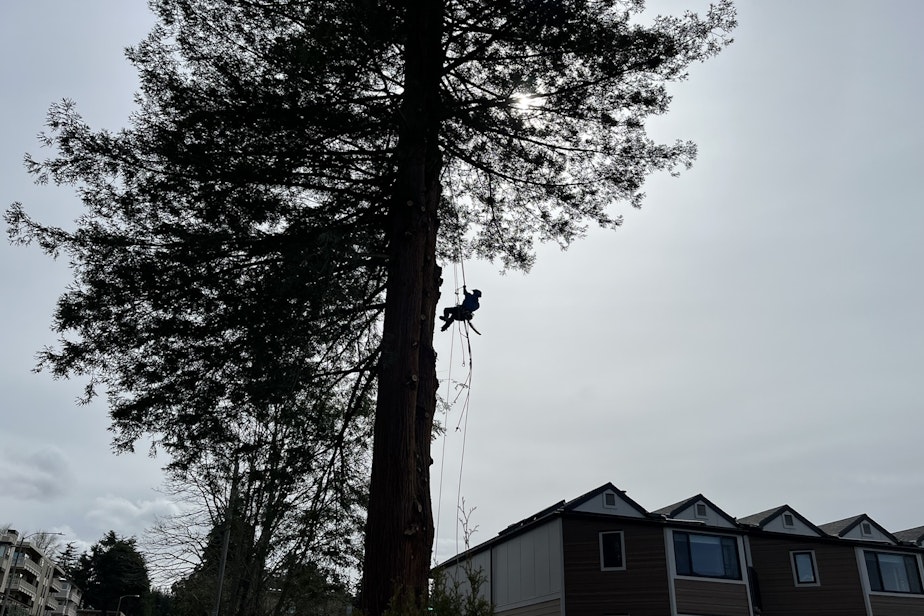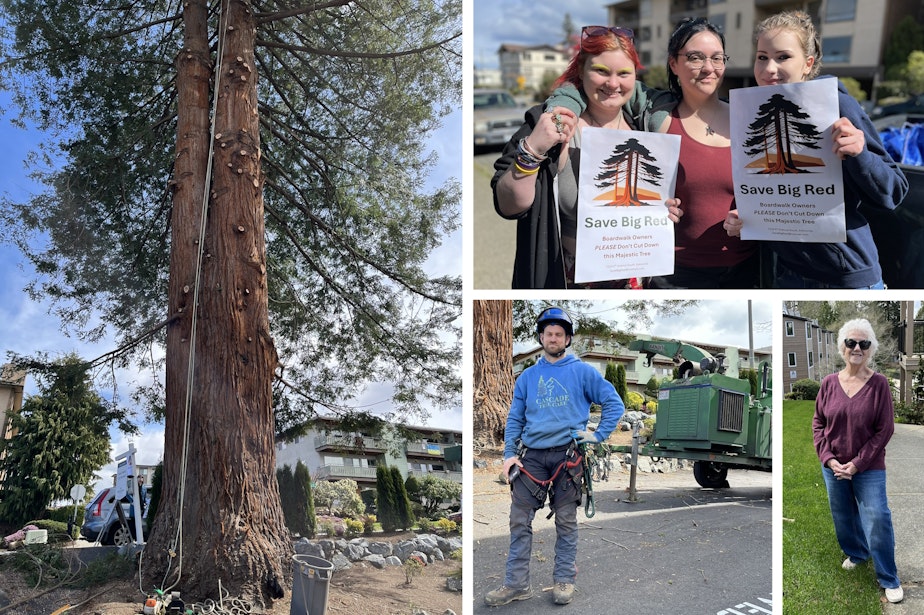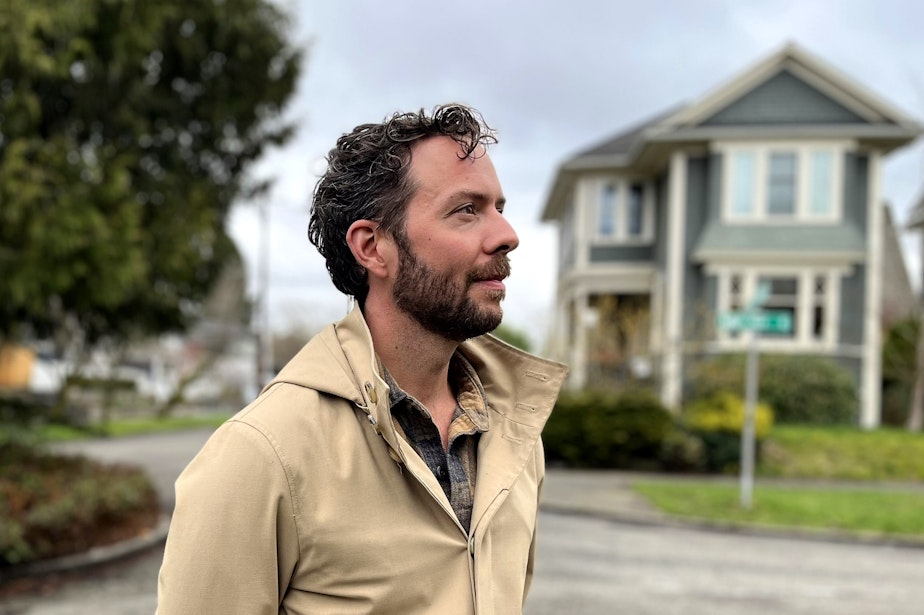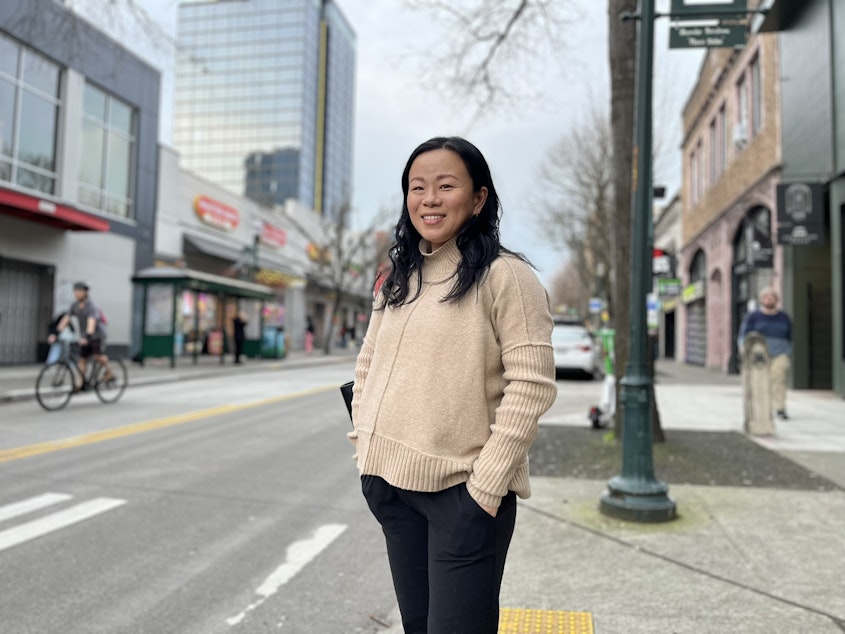Housing, trees, and parking: In Seattle, you can pick two

Cities around Seattle are hemmed in by mountains and sea to the east and west, and protected farms and forests to the north and south. Inside that urban growth boundary, developers turn nooks and crannies into new homes and parking spots.
Almost half of trees lose this standoff.
This story first appeared in KUOW's economy podcast, Booming.
Seattle’s new plan for growth will allow four homes on each residential lot. In some cases, it will allow for six. It’s a big shift.
"We're charting a path forward, preparing for growth, taking on the housing and climate crises," said Seattle Mayor Bruce Harrell in an video about the One Seattle Plan.
The idea is simple: Build more housing, keep prices from soaring.
RELATED: The Sun Belt's shine has dulled. Here's what it means for Seattle home prices
"We are in a deepening crisis," Patience Malaba said while waiting in line to get into a recent public meeting about the plan. "And the only solution is to build more housing."
Sponsored
But there's a tradeoff. To make room for homes — and the driveways, garages, and parking spots that often come with them — Seattle is losing trees.
"I'm here to speak for the trees," said Cil Pierce, who went to City Hall to testify against Seattle’s plan. "They're promoting density at the cost of the trees."
That’s a problem, especially when the city is trying to grow its tree canopy to fight climate change.
In Edmonds, a condo board decided to cut down a 100-year-old coastal redwood. Protesters showed up with "Save Big Red" signs. The arborist tasked with removing it was nervous — not about the height but the backlash.
"I already received a one-star review from one of the protesters here," said Derek Meyers of Cascade Tree Care.
Sponsored
He said he’d already spent money on permits and a crane. Backing out wasn't really an option. Plus, he'd made a promise to his clients; abandoning his commitment to them could lead to negative reviews from the other direction.
RELATED: Seattle's new zoning rules dial up tension around preserving tree canopy

Dee Day, a high school student, wasn’t having it.
"This is our future that we are actively watching be cut down and stomped all over," Dee said.
Sponsored
"No one is excited about taking down the tree,” said Carol Merrill, the condo board's treasurer. “But it's part of the board's obligation to do the best for the property."
The board had recently repaved its asphalt parking lot, after it had grown bumpy from the tree's roots. Taking out the tree protected that investment, Merrill said.

It all comes down to priorities. Sometimes it's parking over trees. Other times, it's housing.
From 2010 to 2020, Seattle built just one new home for every three jobs created. And that trend of adding jobs faster than housing continues.
New housing construction accounts for 20% of tree loss in neighborhoods. But the vast majority of trees are lost because of other reasons. One of the biggest killers is drought. That’s what’s claiming birch trees across Pacific Northwest cities. Drought stresses them, then the pests move in, killing them slowly from the top down.
Sponsored
Between 2016 and 2021, Seattle lost enough trees to cover nearly 200 football fields — almost 2% of its canopy. Tree advocates say it's going in the wrong direction.
Why do trees matter so much? Shade. Cooling. That means resilience in hot summers.
But what’s the tradeoff? One medium tree could mean two fewer townhomes. It could prevent a development from building on clear, flat ground, driving up costs. Housing projects could be shelved, rather than built.

"Do you want a family to live here or not?" said architect and developer Hans Rasmussen de los Rios. "Do you want to have space where immigrants and refugees can afford to live here and get by in the city?"
Sponsored
In his office, he pointed to a table scattered with site plans sketched out on small pieces of paper. On these plans, he arranged townhomes like a game of Tetris. With the tree, 15 homes. Without the tree, 17. But he needs to hit a 15% profit margin to get a loan.
"If you can't hit that threshold, the project doesn't work," he said.
He isn’t alone. It’s happening all over the city, especially in neighborhoods where growth is highly concentrated. About 40% of the time, trees lose. Often, de los Rios tries to slip in a small courtyard with a tree in the middle. But in some places, Seattle requires parking spaces. Those usually take out a the tree. It’s as if, while playing Tetris, the game suddenly dropped an awkward, car-shaped block on you. It would mess up your game.
But it doesn’t have to be that way.
RELATED: The plan to boost Black homeownership
Vivek Shandas, a professor at Portland State, is rethinking how neighborhoods are built. The question driving his research is this: "Can we increase density while not amplifying temperatures in the neighborhood?"
Shandas has modeled several strategies to determine how subtle design changes can change the temperature of a city.
His recommendations include:
- Plant trees on the south and west sides of apartment buildings, or on the southwest corner.
- Paint buildings white and use white roofing materials to reflect heat.
- Install tree wells on one side of the street, taking out a few of the parking stalls but still allowing parking in between them (there are examples in Portland). In this way, a wide street that formerly sucked in and radiated back the heat of the sun can become a shady boulevard, especially where electrical utilities have been buried underground, permitting trees to grow taller.
Several of Shanda's strategies can be expanded and combined, he said. When combined, they offer a new model for city blocks in cities like Portland and Seattle.
As our canvas, we'll start with an block full of existing spaced out single family homes, with their trees and parking spaces, in a neighborhood in need of much more housing. The block contains about 16 homes, plus their trees and parking spaces.
Now, on that block imagine instead a ring of rowhouses, circling the block. They're packed edge to edge, right up to the sidewalk. And all the space you’ve saved by building rowhouses leaves a huge shared green space in the center — big enough to save the mature backyard trees that were already there. It'd be almost like having a private park, shared by the whole block. Plant more trees along the outside perimeter streets to cool the asphalt and concrete, and add periodic breaks in the wall of rowhouses to let breezes travel through the center green space.
That block layout fits 64 homes where only 16 used to be. And the high summer temperatures there would likely be cooler than when the block was covered in single family homes and their parking spaces, Shandas said.
"It is recognizing a part of the landscape that was there in the past and makes humans just a part of what that ecosystem was," Shandas said. “And that’s what delights me – being able to preserve a little patch of nature when we're really eager to develop it and in many ways just eliminate it."
But here’s the twist: More trees are lost to parking than to housing itself.
RELATED: Should Washington cities cut down on parking spots required at new developments?
"For every one of these properties where you're losing livable square-footage to a tree, there are five or perhaps even 10 where trees are being cut in order to make space for things like driveways, parking garages, parking spaces," said Susan Su, a prominent tree advocate and investor in climate technologies.

Parking isn't trivial. But it quietly shapes what gets built — and what comes down.
Despite her advocacy for trees, Su said she does not blame developers for the creeping loss of tree canopy on residential lots.
"If developers were incentivized and given the flexibility to retain trees, they as designers could easily find ways to" save more trees, she said. "Right now, we're actually disincentivizing that behavior, and we're in fact even punishing them in ways."
RELATED: Seattle claims to 'protect' hundreds of trees that were never threatened
So, what kind of incentives would work for architects like Hans Rasmussen de los Rios? For him, flexibility is key, too. An offer to build taller in exchange for saving a tree can push up construction costs, for example. But with many different kinds of incentives offered in exchange for saving trees, developers could choose the solution that lets them satisfy their banks.
At the end of the day, it’s a battle for space — between housing, parking, and trees.
We can’t have all three. Not in equal measure.
Right now, trees are slowly losing. But with sufficient incentives in place, that could change.
Hear more about trees, housing and parking on the latest episode of Booming:


